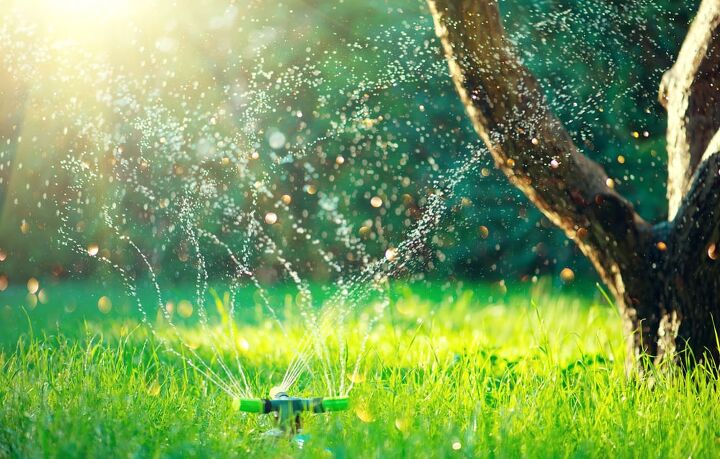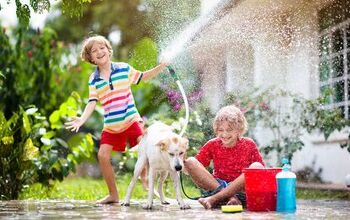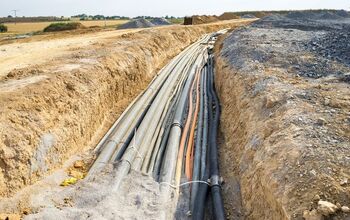4 Alternatives To Underground Sprinkler Systems

A healthy lawn generates curb appeal, keeps you in your neighbor’s good graces, and is something to be proud of. The best way to ensure a healthy lawn is to install a sprinkler system, but unfortunately, that means spending a fortune. With that said, how can you avoid extreme expenses with alternatives to underground sprinkler systems?
The best underground sprinkler system alternative is manual sprinklers, drip irrigation, rotor sprinklers, and watering by hand. Drip irrigation is ideal for large plots of land, and it is affordable because no digging is done. Manual sprinklers are also affordable because no electrical work is done, but watering by hand is the cheapest option.
Irrigating your lawn can cost a fortune, but underground sprinkler systems are not your only option. Let’s take a close look at some of the best alternatives to underground sprinkler systems.
Top Underground Sprinkler Alternatives
1. Manual Sprinkler
Manual sprinklers are an affordable, effective, and easy-to-use underground sprinkler alternative. They work on the same principle as underground systems, but manual sprinklers are not automated. Manual sprinklers put the control in your hands as you decide when you turn the sprinkler system on and off.
You can expect to pay between $0.60 and $0.70 per square foot to install a manual sprinkler system. Manual sprinklers are so affordable because there is no elaborate electrical work like with an underground system. The installation process is also much less labor-intensive, and that makes manual sprinklers much cheaper.
You will have to pay attention to your manual sprinkler usage so that you don’t overwater your lawn. There is no automation on manual sprinklers, so it may take some time for you to figure out how long you need to run it. Look into manual sprinklers if you want to save money on installation and electrical bills.
Pros- No electrical work
- Cheap installation
- Reliable
- Long-lasting
- Not automated
- Learning curve
2. Drip Irrigation
If you have a lot of land to cover, drip irrigation is a great underground sprinkler system alternative. Drip irrigation distributes both water and fertilizer across your yard or land, and it’s commonly used by farmers. With that said, plenty of homeowners with yards of all sizes use drip irrigation because of the efficiency and convenience.
Not all drip irrigation systems infuse fertilizer into the water, but it can be done. The water makes its way through plastic pipes that reach drippers that slowly drip the water out. This makes drip irrigation systems ideal for homeowners with an acre of land, but they work with smaller lots as well.
You can expect to pay between $500 and $2,100 or more to install a drip irrigation system. It all depends on how much land your drip irrigation covers and a full acre usually exceeds $2,000. Consider a drip irrigation system as an alternative to underground sprinklers if you have a lot of land.
Pros- Covers a lot of lands
- Some systems disperse fertilizer
- Low-maintenance
- Expensive installation
- High water bills
3. Rotor Sprinkler
Rotor sprinklers are different than traditional underground spray head sprinkler systems in several ways. One of the key parts of a sprinkler system is the sprinkler heads, and rotor heads are completely distinct. Rotor sprinkler heads are larger than typical spray heads, and they can cover more land than the average underground system.
You should consider a rotor sprinkler if you need to water a large radius, and it’s ideal for hard soil. They also are known for spraying water more evenly than traditional spray heads, and that contributes to a healthy lawn. The one downside to rotor sprinklers is that they are much louder than a typical underground sprinkler.
You can expect to pay at least $1,100 to install a rotor sprinkler system, but it can cost more. Rotor sprinkler systems are known to sometimes require more maintenance than other types of sprinklers. Look into rotor sprinkler systems if you want to evenly distribute water over a large chunk of land.
Pros- Unlikely to clog
- Even water distribution
- Covers a lot of lands
- Maintenance required
- Expensive installation
4. Garden Hose
Not all yards are large enough to warrant spending thousands of dollars on a sprinkler system. If you have a small yard, chances are that you don’t need to use anything more than a garden hose. A simple combination of a garden hose and a watering can is all that you need for small yards.
Sure, watering your yard by hand is time-consuming, but it is worth the savings for many homeowners. Dedicate between 30 and 45 minutes to watering your lawn by hand if you have a small to mid-sized yard. Make sure that you cover the lawn and your plants evenly as it can be harder to gauge than a sprinkler system.
Look into a soaker hose if you want to cover a lot of land at once, and you’ll use 0.6 gallons per foot. Otherwise, look into nozzles that have up to 10 positions so that you can experiment with your ideal setting. You can save yourself up to thousands of dollars if you choose to use a garden hose instead of a sprinkler system.
Pros- Saves money
- Conserves water
- No installation required
- Time-consuming
- Hard to gauge how much water to use
Drip Irrigation vs. Sprinkler
Drip irrigation and underground sprinkler systems are different in both function and cost. Sprinkler systems are not ideal for large properties, but that’s where drip irrigation shines. Most homeowners only choose drip irrigation if they have at least an acre of land.
You might pay up to $2,100 to cover an acre with drip irrigation, but a sprinkler system could cost over $10,000 for the same space. That is because underground sprinkler systems require expensive electrical work and labor. Also, drip irrigation systems sit above ground which knocks hundreds or thousands of dollars off of their installation.
Drip irrigation is also useful for small plots of land, especially when compared to sprinkler systems. For example, it costs over $2,400 to cover a ¼ acre space with a sprinkler system. However, it may cost as little as $500 to install drip irrigation on ¼ acre of land.
Manual vs. Automatic
It can be difficult to choose between manual and automatic irrigation for many homeowners. That’s because they each have benefits and downsides that are unique to themselves. For example, manual systems are much cheaper than automatic systems, but they also are harder to use.
Automatic sprinkler systems offer convenience in a way that manual irrigation simply cannot, and some say that is worth the cost. Manual irrigation requires that you turn on the system to begin and shut it off when you are ready to be done. That makes it difficult to learn just how much water your lawn needs to stay healthy.
Manual sprinkler systems are cheap to install and generally only cost $0.60 per foot depending on who you hire. Automatic systems cost at least $0.20 more per foot, plus the added labor for electrical work and digging. These costs add up, and that makes automatic irrigation the convenient choice, and manual systems the cost-effective choice.
Do You Need A Sprinkler System?
You don’t need a sprinkler system unless you want to add value to your home. You can add as much as $3,000 in value to your home with a sprinkler system, so it’s worth the investment. With that said, sprinkler systems are optional and foregoing one isn’t a death sentence.
A green lawn adds curb appeal and value to your home, and irrigation is the best way to do that. Even if you don’t install an irrigation system of some sort, you should still water your lawn. Manual watering with a hose is a must if you decide to go without a sprinkler system.
You may have a hard time selling your home if you don’t have irrigation in place. If you are worried about money, then go with a manual sprinkler or drip irrigation system. Otherwise, spend the $2,000-$3,000 on a sprinkler system and you’ll get it back when you sell.
Related Questions
Do you have to winterize underground sprinkler systems?
It is recommended that you winterize your underground sprinkler system if you live somewhere with cold winters. Failure to winterize your underground sprinkler system can cause the pipes to freeze and lead to damage. Freezing water can damage your pipes and sprinkler heads, and cause them to burst permanently damaging the system.
Do sprinkler systems increase home value?
Yes, sprinkler systems can add value to your home by as much as $3,000 when it comes time to sell. This is not quite a large return on investment due to the high cost of installation, but it still makes the house more desirable. Sprinkler systems also add curb appeal, particularly if your lawn is green, lush, and healthy when you show it to potential buyers.
Should sprinklers hit your house?
Sprinklers should not hit your house, and in fact, it’s a major waste of water. It all comes down to sprinkler head placement, and they may need to be adjusted if it hits your house. Sprinklers that hit your house are likely missing spots of the lawn that need water.
Summing It Up
The most simple underground sprinkler alternative is a manual sprinkler system, and they’re affordable. However, you will have to turn them on, and which can be tricky when it comes to gauging the amount of water. Otherwise, you could invest in a drip irrigation system that foregoes digging and expensive installation.
You can also invest in a rotor sprinkler system if you want to cover a large plot of land. The cheapest underground sprinkler alternative is watering by hand, but that can be tough. You’ll need to buy a garden hose head that has multiple settings so that you can experiment.
If you don’t want an underground sprinkler system, you should at least get an irrigation system of some sort. Irrigation systems add value to your home and can help you sell it when you are ready to move on. Choose the underground sprinkler alternative that best suits your lawn, budget, and personal taste.
More Related Guides

Nick Durante is a professional writer with a primary focus on home improvement. When he is not writing about home improvement or taking on projects around the house, he likes to read and create art. He is always looking towards the newest trends in home improvement.
More by Nick Durante


















![How Much Weight Can a 4×4 Support Horizontally? [It Depends!]](https://cdn-fastly.upgradedhome.com/media/2023/07/31/9070333/how-much-weight-can-a-44-support-horizontally-it-depends.jpg?size=350x220)








![10 Most Dangerous Neighborhoods in Baltimore [Updated]](https://cdn-fastly.upgradedhome.com/media/2023/07/31/9075655/10-most-dangerous-neighborhoods-in-baltimore-updated.jpg?size=350x220)



